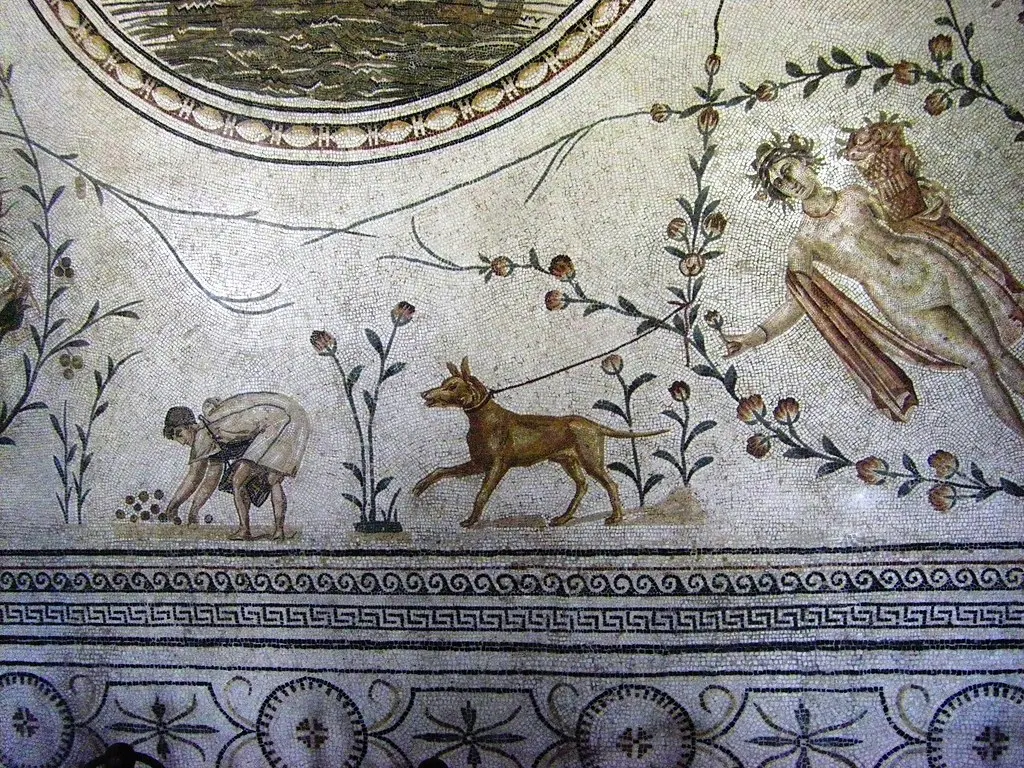Mosaic floor tiles of a Roman temple

Mosaic floor tiles of a Roman temple
Mosaics once adorned the floor of a room measuring almost 500 square feet which undeniably served Christian worship in the 3rd century, a time before Christianity became more widely accepted and popular after the time of Constantine. In many ways, this small room gives us a sense of a church community that lived southwest of the Sea of Galilee before the more formal structure of the church developed in later centuries. Today it is common to emphasize the natural features of food products or other objects. This room and its decorations give a very clear picture of the Christian community.
Mosaics are patterns or images made of many small colourful stones or tile cubes (called tesserae in Latin) commonly found on Roman buildings and used to show the wealth of the Romans. In the city of Chichester it is known as the Noviomagus Reginorum. This fragment discovered in 1966 is almost certainly part of the floor of a public building. The remains of six further rooms from the same period have been identified extending beneath the south eastern quadrangle of the cathedral.
Mosaicfloor,Mosaictemple,Mosaic,Akkadian,Alexander,egypt,AlKhab,trojan,Achilles,antinous,ArchitectureRoman,Apollo,Artemis,Aztec,CorfeCastle,HOME,features,formatplace,FORUM,Temple of Vesta or Hercules Victor, mosaic, Italy
In the Mayan civilization, where this art form developed independently mosaics were an art form of creating images by assembling small pieces of stained glass stone or other materials. Instead of creating an image by adding color to a flat surface by arranging hundreds or thousands of small colored tiles and calling this art form "mosaic". This unique art form can create beautiful and fascinating patterns on the walls and floors of temples and architecture. The Megiddo mosaic can be seen from many perspectives whether it is ancient art, the architectural perspective of the sanctuary in the early church or an example of how local faith communities supported the trade of workers in their church. In a remarkable story, it is a beautiful picture of a small group and also an example of the words of the Apostle Paul "There is neither Jew nor Gentile there is neither slave nor free there is neither male nor female for you are all one in Christ Jesus."
Another ancient mosaic pattern of Megiddo that can be seen from many perspectives whether it is ancient art in the sacred place of the early church and an example of the local faith community. According to the story of the history in the architectural perspective on the wall such as the legend of the Muses the god Apollo the legendary scene of the victory of Neptune the legend of Orpheus including the local mosaic pattern such as the hunting art that often has dogs local agriculture fishing or circus games in the ancient culture era are still important topics and perspectives that are very popular for mosaics. Mosaic art forms with images that use natural seasonal materials Images that tell the story of local stories such as the waves of the four seasons are also the topics of the patterns on many mosaic works that are shown as images of sea animals and people in that era.
The mosaics used to decorate the floors of the room are mostly of different sizes but the most elaborate ones are almost 500 square feet in size and they undeniably served Christian worship in the 3rd century before Christianity was accepted and became more popular after the time of Constantine. In many ways this small room gives us a sense of a church community that lived southwest of the Sea of Galilee before the more formal structure of the church developed in the following centuries. Today it is common to emphasize the natural features of food products or other objects. This room and its decoration give a very clear picture of the Christian community. Other important Venetian mosaics can be found in the 12th century Cathedral of Santa Maria Assunta in Torcello and in the Basilica of Santi Maria e Donato in Murano.
Temple of Asclepius floor mosaic Roman
Along with restored 12th century apsis mosaics and a beautiful floor mosaic the apsis of the church of San Cipriano in Murano is decorated with an impressive golden mosaic from the early 13th century showing Jesus enthroned with the Virgin Mary St. John and the two patron saints. The ancient art of the tile patterns can be seen from many perspectives ancient works of art architectural aspects of the sanctuary of the early Church or examples of how local faith communities financially supported the work of their churches. However, one of the most remarkable stories is the beautiful image of a small group that exemplifies the words of the Apostle Paul “There is neither Jew nor Gentile there is neither slave nor free there is neither male nor female for you are all one in Christ Jesus.”
museumofthebible
helenmilesmosaics.org











